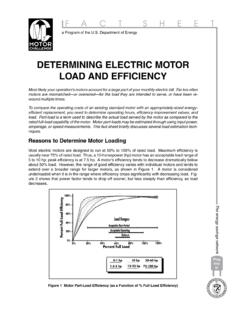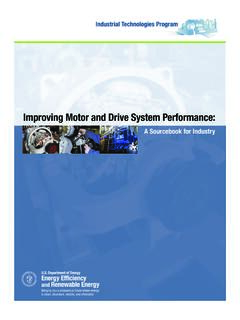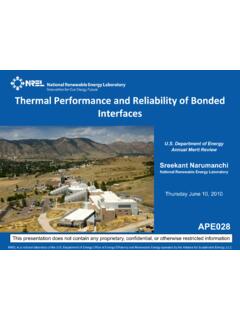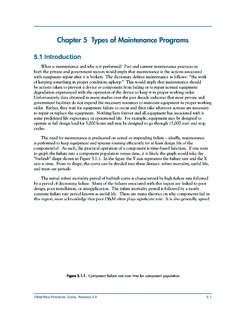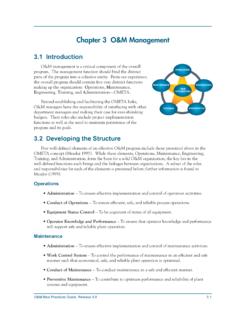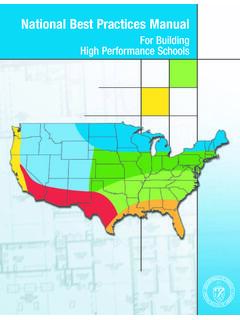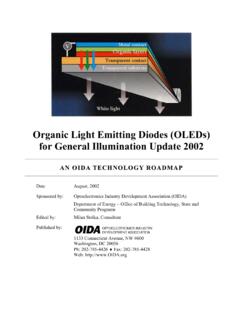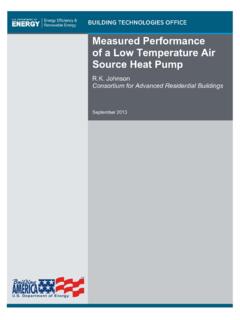Transcription of Chapter 6 Predictive Maintenance Technologies
1 Chapter 6 Predictive Maintenance Technologies Introduction Predictive Maintenance attempts to detect the onset of a degradation mechanism with the goal of correcting that degradation prior to significant deterioration in the component or equipment. The diagnostic capabilities of Predictive Maintenance Technologies have increased in recent years with advances made in sensor Technologies . These advances, breakthroughs in component sensitivities, size reductions, and most importantly, cost, have opened up an entirely new area of diagnostics to the O&M practitioner. As with the introduction of any new technology, proper application and TRAINING is of critical importance. This need is particularly true in the field of Predictive Maintenance technology that has become increasingly sophisticated and technology-driven. Most industry experts would agree (as well as most reputable equipment vendors) that this equipment should not be purchased for in-house use if there is not a serious commitment to proper implementation, operator training, and equipment monitoring and repair.
2 If such a commitment cannot be made, a site is well advised to seek other methods of program implementation a preferable option may be to contract for these services with an outside vendor and rely on their equipment and expertise. Table below highlights typical applications for some of the more common Predictive Maintenance Technologies . Of course, proper application begins with system knowledge and Predictive technology capability before any of these Technologies are applied to live systems. Table Common Predictive technology applications (NASA 2000). Heavy Equipment/. Electrical Systems Diesel Generators Heat Exchangers Circuit Breakers Electric Motors Tanks, Piping Transformers Applications Condensers Cranes Pumps Valves Technologies Vibration Monitoring/Analysis X X X X. Lubricant, Fuel Analysis X X X X X. Wear Particle Analysis X X X X. Bearing, Temperature/Analysis X X X X. Performance Monitoring X X X X X X. Ultrasonic Noise Detection X X X X X X X. Ultrasonic Flow X X X X.
3 infrared Thermography X X X X X X X X X X. Non-destructive Testing (Thickness) X X X. Visual Inspection X X X X X X X X X X X. Insulation Resistance X X X X X. Motor Current Signature Analysis X. Motor Circuit Analysis X X X. Polarization Index X X X. Electrical Monitoring X X. O&M Best Practices Guide, Release Predictive Maintenance Technologies Thermography Introduction infrared (IR) thermography can be defined as the process of generating visual images that repre- sent variations in IR radiance of surfaces of objects. Similar to the way objects of different materials and colors absorb and reflect electromagnetic radiation in the visible light spectrum ( to microns), any object at temperatures greater than absolute zero emits IR energy (radiation) proportional to its existing temperature. The IR radiation spectrum is generally agreed to exist between and 15 microns. By using an instrument that contains detectors sensitive to IR electromagnetic radiation, a two-dimensional visual image reflective of the IR radiance from the surface of an object can be generated.
4 Even though the detectors and electronics are different, the process itself is similar to that a video camera uses to detect a scene reflecting electromagnetic energy in the visible light spectrum, interpreting that information, and displaying what it detects on a liquid crystal display (LCD) screen that can then be viewed by the device operator. Because IR radiation falls outside that of visible light (the radiation spectrum to which our eyes are sensitive), it is invisible to the naked eye. An IR camera or similar device allows us to escape the visible light spectrum and view an object based on its temperature and its proportional emittance of IR radiation. How and why is this ability to detect and visualize an object's temperature profile important in maintaining systems or components? Like all Predictive Maintenance Technologies , IR tries to detect the presence of conditions or stressors that act to decrease a component's useful or design life. Many of these conditions result in changes to a component's temperature.
5 For example, a loose or corroded electrical connection results in abnormally elevated connection temperatures due to increased electrical resistance. Before the connection is hot enough to result in equipment failure or possible fire, the patterns are easily seen through an IR imaging camera, the condition identified and corrected. Rotating equipment problems will normally result in some form of frictional change that will be seen as an increase in the component's temperature. Faulty or complete loss of refractory material will be readily seen as a change in the components thermal profile. Loss of a roof's membrane integrity will result in moisture that can be readily detected as differences in the roof thermal profile. These are just a few general examples of the hundreds of possible applications of this technology and how it might be used to detect problems that would otherwise go unnoticed until a component failed and resulted in excessive repair or downtime cost. Types of Equipment Many types of IR detection devices exist, varying in capability, design, and cost.
6 In addition, simple temperature measurement devices that detect IR emissions but do not produce a visual image or IR profile are also manufactured. The following text and pictures provide an overview of each general instrument type. Spot Radiometer ( infrared Thermometer) Although not generally thought of in the world of thermography, IR thermometers use the same basic principles as higher end equipment to define an object's temperature based on IR emissions. These devices do not provide any image Figure Typical IR spot thermometer representative of an object's thermal profile, but rather a value representative of the temperature of the object or area of interest. O&M Best Practices Guide, Release Predictive Maintenance Technologies infrared Imager As indicated earlier, equipment capabilities, design, cost, and functionality vary greatly. Differences exist in IR. detector material, operation, and design. At the fundamental level, IR detection devices can be broken down into two main groups.
7 Imagers and cameras with radiometric capability. A simple IR. imager has the ability to detect an object's IR emissions and translate this information into a visual image. It does not have the capability to analyze and quantify specific temperature values. This type of IR detection device can be of use when temperature values Figure Internal house wall. are unimportant and the object's temperature profile (represented Note dark area indicating cooler by the image) is all that is needed to define a problem. An example temperatures because of heat loss. of such an application would be in detecting missing or inadequate insulation in a structure's envelope. Such an application merely requires an image representative of the differences in the thermal profile due to absence of adequate insulation. Exact temperature values are unimportant. IR cameras with full radiometric capability detect the IR emissions from an object and translate this information into a visible format as in the case of an imager.
8 In addition, these devices have the capability to analyze the image and provide a temperature value corresponding to the area of interest. This capability is useful in applications where a temperature value is important in defining a problem or condition. For example, if an image indicated a difference between a pulley belt temperature and an ambient temperature, the belt may have worn, be the wrong size, or indicate a misalignment condition. Knowing the approximate temperature differences would be important in determining if a problem existed. Figure Temperature is used in defining belt problems. Figure shows a belt temperature of 149 F, and ambient temperature of 67 F for a difference of 82 F. The difference should be trended over time to determine slippage that would be indicated by a higher temperature difference. O&M Best Practices Guide, Release Predictive Maintenance Technologies System Applications Electrical System Applications The primary value of thermographic inspections of electrical systems is locating problems so that they can be diagnosed and repaired.
9 How hot is it? is usually of far less importance. Once the problem is located, thermography and other test methods, as well as experience and common sense, are used to diagnose the nature of the problem. The following list contains just a few of the possible electrical system-related survey applications: Transmission lines In-Plant Electrical Systems - Splices - Switchgear - Shoes/end bells - Motor Control Center Inductive heating problems - Bus - Insulators - Cable trays Cracked or damaged/tracking - Batteries and charging circuits Distribution lines/systems - Power/Lighting distribution panels - Splices - Line clamps - Disconnects - Oil switches/breakers - Capacitors - Pole-mounted transformers - Lightning arrestors - Imbalances Substations - Disconnects, cutouts, air switches - Oil-filled switches/breakers (external and internal faults). - Capacitors - Transformers Internal problems Bushings Oil levels Cooling tubes Lightning arrestors - Bus connections Generator Facilities - Generator Bearings Brushes Windings Software analysis tools can quantify and graphically Coolant/oil lines: blockage display temperature data.
10 As shown above, the middle - Motors conductor/connection is a much higher temperature Connections indicating a loose connection. Bearings Winding/cooling patterns Motor Control Center Imbalances O&M Best Practices Guide, Release Predictive Maintenance Technologies Figure Air breaker problem. Highlighted by temperature difference between two different breakers. Likely caused by poor connection. Figure Overloaded contacts show different temperature profiles indicating one contact seeing much greater load, a potentially unsafe situation. Mechanical System Applications Rotating equipment applications are only a small subset of the possible areas where thermography can be used in a mechanical Predictive Maintenance program. In addition to the ability to detect problems associated with bearing failure, alignment, balance, and looseness, thermography can be used to define many temperature profiles indicative of equipment operational faults or failure. The following list provides a few application examples and is not all inclusive: Steam Systems Environmental - Boilers - Water discharge patterns Refractory - Air discharge patterns Tubes Motors and rotating equipment - Traps - Bearings - Valves Mechanical failure - Lines Improper lubrication Heaters and furnaces - Coupling and alignment problems - Refractory inspections - Electrical connections on motors - Tube restrictions - Air cooling of motors Fluids - Vessel levels - Pipeline blockages O&M Best Practices Guide, Release Predictive Maintenance Technologies Figure IR scans of multiple electric motors can highlight those with hot bearings indicting an imbalance or wear problem.


